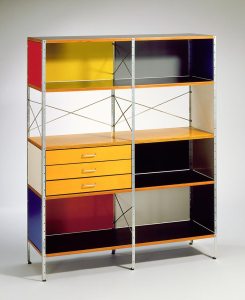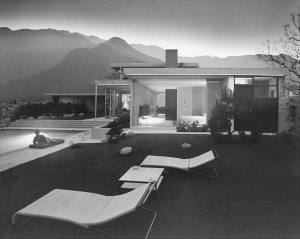‘California Design 1930–1965: Living in a Modern Way’ has spent the last two years skirting the edges of the Pacific Ocean. Opening originally at the Los Angeles County Museum of Art (LACMA) in October 2011, the exhibition has since visited Tokyo’s National Arts Center and the Auckland Art Gallery Toi O Tamaki, prior to arriving in Brisbane – Australia’s third largest city – in early November 2013. Presented at the Queensland Art Gallery/Gallery of Modern Art (QAGOMA), ‘California Design 1930–1965′ showcases over 250 design objects, including furniture, ceramics, metalwork, fashion and textiles, graphic design, architectural drawings and period photographs.

ESU (Eames storage unit) (c.1949), Charles and Ray Eames © 2011 Eames Office LLC (eamesoffice.com); © Herman Miller, Inc. Photo © 2011 Museum Associates/LACMA
Michael Govan, CEO and Director of LACMA went to lengths in a recent interview with Australia-based art magazine ARTAND to affirm US-Australia’s shared heritage as ‘colonial cultures in the shadow of European art’. Today, modernism is inherently a global language, and one that has sunk its claws into most countries. It is also a language based originally in egalitarianism and opportunity, but with a strong, dual identity tempered by capital.
Obviously, this same push and pull sits at the heart of ‘the American dream’ and it is no surprise that it works so well in structuring our understanding and experience of ‘California Design 1930–1965’. Modernism’s relevance is perhaps best appreciated in its flexibility. As exhibition curator Wendy Kaplan succinctly pitched in her opening keynote, Californian modernism was ‘an answer to conditions’. Like Australia, California enjoys a ‘benevolent environment’ which allows for openness in its interpretation of the modernist lexicon. The regional translation or vernacular is where identity is established.
For California, the post-war boom in population and economy created a strong foundation for the future, but also helped to define the state’s specific character. For Australia, despite what QAGOMA’s senior curator Miranda Wallace describes as ‘a decade’s lag’, California’s experimental case study house programme had a distinct and lasting influence on local architecture.
Advances in manufacturing during the Second World War meant new materials including fibreglass and plastics were increasingly applied in a domestic setting. Despite the military-grade gloss, products remained relatively accessible in price. One of the first objects encountered in the exhibition is Richard Neutra’s Boomerang chair, a plywood-winged armchair propped up with thick dowels, the occupier supported by parachute-like webbing. There is a temporary and immediate quality about Neutra’s design that suggests it was driven by a sense of urgency, of fulfilling need.

Kaufmann House Palm Springs (1946), Richard Neutra © J. Paul Getty Trust. Used with permission. Julius Shulman Photography Archive, Research Library at the Getty Research Institute
Neutra is best known for his houses, exemplified in the exhibition by Julius Shulman’s image of his 1946 Kaufmann House in Palm Springs. Shown nearby, Shulman’s idyllic interior scenes today smack of pure aspiration – tastefully minimal, counter tops cleared of clutter. Back then they played both ways, widely promoting a contemporary, accessible ‘ideology’ where less meant more, as well as advocating an increasingly unrealistic, class-based dream.
Still in production today, Charles and Ray Eames’ iconic leather and moulded plywood armchair and ottoman sit rightfully at the heart of the exhibition space. You can buy your own for AUD $5750. Even Neutra’s Boomerang hits the USD $1500 mark. In highlighting modernism’s regional identity, ‘California Design 1930–1965’ succeeds admirably. However, as we venture further into the 21st century, significant instability in the once benevolent environment and widespread austerity will continue to bite into the reality of the modernist dream it promotes.
‘California Design 1930-1965: Living in a Modern Way’ is at Queensland Art Gallery | Gallery of Modern Art, Brisbane from 2 November 2013 to 9 February 2014.

The Modern Way
Kaufmann House Palm Springs (detail; 1946), Richard Neutra © J. Paul Getty Trust. Used with permission. Julius Shulman Photography Archive, Research Library at the Getty Research Institute
Share
‘California Design 1930–1965: Living in a Modern Way’ has spent the last two years skirting the edges of the Pacific Ocean. Opening originally at the Los Angeles County Museum of Art (LACMA) in October 2011, the exhibition has since visited Tokyo’s National Arts Center and the Auckland Art Gallery Toi O Tamaki, prior to arriving in Brisbane – Australia’s third largest city – in early November 2013. Presented at the Queensland Art Gallery/Gallery of Modern Art (QAGOMA), ‘California Design 1930–1965′ showcases over 250 design objects, including furniture, ceramics, metalwork, fashion and textiles, graphic design, architectural drawings and period photographs.
ESU (Eames storage unit) (c.1949), Charles and Ray Eames © 2011 Eames Office LLC (eamesoffice.com); © Herman Miller, Inc. Photo © 2011 Museum Associates/LACMA
Michael Govan, CEO and Director of LACMA went to lengths in a recent interview with Australia-based art magazine ARTAND to affirm US-Australia’s shared heritage as ‘colonial cultures in the shadow of European art’. Today, modernism is inherently a global language, and one that has sunk its claws into most countries. It is also a language based originally in egalitarianism and opportunity, but with a strong, dual identity tempered by capital.
Obviously, this same push and pull sits at the heart of ‘the American dream’ and it is no surprise that it works so well in structuring our understanding and experience of ‘California Design 1930–1965’. Modernism’s relevance is perhaps best appreciated in its flexibility. As exhibition curator Wendy Kaplan succinctly pitched in her opening keynote, Californian modernism was ‘an answer to conditions’. Like Australia, California enjoys a ‘benevolent environment’ which allows for openness in its interpretation of the modernist lexicon. The regional translation or vernacular is where identity is established.
For California, the post-war boom in population and economy created a strong foundation for the future, but also helped to define the state’s specific character. For Australia, despite what QAGOMA’s senior curator Miranda Wallace describes as ‘a decade’s lag’, California’s experimental case study house programme had a distinct and lasting influence on local architecture.
Advances in manufacturing during the Second World War meant new materials including fibreglass and plastics were increasingly applied in a domestic setting. Despite the military-grade gloss, products remained relatively accessible in price. One of the first objects encountered in the exhibition is Richard Neutra’s Boomerang chair, a plywood-winged armchair propped up with thick dowels, the occupier supported by parachute-like webbing. There is a temporary and immediate quality about Neutra’s design that suggests it was driven by a sense of urgency, of fulfilling need.
Kaufmann House Palm Springs (1946), Richard Neutra © J. Paul Getty Trust. Used with permission. Julius Shulman Photography Archive, Research Library at the Getty Research Institute
Neutra is best known for his houses, exemplified in the exhibition by Julius Shulman’s image of his 1946 Kaufmann House in Palm Springs. Shown nearby, Shulman’s idyllic interior scenes today smack of pure aspiration – tastefully minimal, counter tops cleared of clutter. Back then they played both ways, widely promoting a contemporary, accessible ‘ideology’ where less meant more, as well as advocating an increasingly unrealistic, class-based dream.
Still in production today, Charles and Ray Eames’ iconic leather and moulded plywood armchair and ottoman sit rightfully at the heart of the exhibition space. You can buy your own for AUD $5750. Even Neutra’s Boomerang hits the USD $1500 mark. In highlighting modernism’s regional identity, ‘California Design 1930–1965’ succeeds admirably. However, as we venture further into the 21st century, significant instability in the once benevolent environment and widespread austerity will continue to bite into the reality of the modernist dream it promotes.
‘California Design 1930-1965: Living in a Modern Way’ is at Queensland Art Gallery | Gallery of Modern Art, Brisbane from 2 November 2013 to 9 February 2014.
Unlimited access from just $16 every 3 months
Subscribe to get unlimited and exclusive access to the top art stories, interviews and exhibition reviews.
Share
Recommended for you
Ideal Man
The Musée d’Orsay’s exhibition of male nudes is almost a great show, but it misses a timely opportunity to explore homoerotic sentiment in art
Political Sympathy – Daumier at the Royal Academy
The political context of Daumier’s work is important, but doesn’t need over-stating: the humour and compassion of his art speaks for itself
Draughtsmen
Masculinity is having a moment. The Wallace Collection’s ‘The Male Nude’ follows the Musée d’Orsay’s lead and takes a closer look at men in art